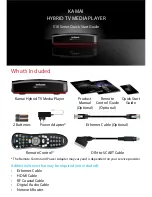
1-19
DVP-NC85H
1-19E
75
Additional Informat
ion
9.4 GB, and double-layer and double-sided
DVD is 17 GB.
The picture data uses the MPEG 2 format, a
worldwide standard of digital compression
technology. The picture data is compressed to
about 1/40 (average) of its original size. The
DVD also uses a variable rate coding
technology that changes the data to be
allocated according to the status of the
picture. Audio information is recorded in a
multi-channel format, such as Dolby Digital,
allowing you to enjoy a more realistic audio
presence.
Furthermore, various advanced functions
such as the multi-angle, multilingual, and
Parental Control functions are provided with
the DVD.
DVD-RW (page 7)
A DVD-RW is a recordable and rewritable
disc that is the same size as a DVD VIDEO.
The DVD-RW has two different modes: VR
mode and Video mode. DVD-RWs created in
Video mode have the same format as a DVD
VIDEO, while discs created in VR (Video
Recording) mode allow the contents to be
programmed or edited.
DVD+RW (page 7)
A DVD+RW (plus RW) is a recordable and
rewritable disc. DVD+RWs use a recording
format that is comparable to the DVD VIDEO
format.
File (page 52, 55)
A JPEG image recorded on a DATA CD/
DATA DVD (“File” is an exclusive
definition for this player.) A single file
consist of a single image.
Film based software, Video based
software (page 21)
DVDs can be classified as Film based or
Video based software. Film based DVDs
contain the same images (24 frames per
second) that are shown at movie theaters.
Video based DVDs, such as television
dramas or sit-coms, displays images at 30
frames/60 fields per second.
HDMI (High-Definition Multimedia Interface)
HDMI is an interface that supports both video
and audio on a single digital connection. The
HDMI connection carries standard to high
definition video signals and multi-channel
audio signals to AV components such as
HDMI equipped TVs, in digital form without
degradation.
Since the video signals are compatible with
the current DVI (Digital Visual Interface)
format, HDMI jacks can be connected to DVI
jacks by way of an HDMI-DVI converter
cord. The HDMI specification supports
HDCP (High-bandwidth Digital Contents
Protection), a copy protection technology that
incorporates coding technology for digital
video signals.
Normal (Interlace) format (page 21)
Normal (Interlace) format shows every other
line of an image as a single “field” and is the
standard method for displaying images on
television. The even number field shows the
even numbered lines of an image, and the odd
numbered field shows the odd numbered lines
of an image.
Progressive format (page 21)
Compared to the Interlace format that
alternately shows every other line of an image
(field) to create one frame, the Progressive
format shows the entire image at once as a
single frame. This means that while the
Interlace format can show 30 frames/60 fields
in one second, the Progressive format can
show 60 frames in one second. The overall
picture quality increases and still images,
text, and horizontal lines appear sharper. This
player is compatible with the 480 progressive
format.
Progressive JPEG
Progressive JPEGs are used mostly on the
internet. They are different from other JPEGs
in that they “fade in” gradually instead of
being drawn from top to bottom when
displayed on a browser. This lets you view the
image while it is being downloaded.
Title (page 12)
The longest section of a picture or music
feature on a DVD, movie, etc., in video
software, or the entire album in audio
software.
76
Specifications
System
Laser:
Semiconductor laser
Signal format system:
NTSC
Audio characteristics
Frequency response:
DVD VIDEO (PCM
96 kHz): 2 Hz to 44 kHz (±1.0 dB)/DVD
VIDEO (PCM 48 kHz): 2 Hz to 22 kHz
(±0.5 dB)/CD: 2 Hz to 20 kHz (±0.5 dB)
Signal-to-noise ratio (S/N ratio):
115 dB
(LINE OUT L/R (AUDIO) jacks only)
Harmonic distortion:
0.003 %
Dynamic range:
DVD VIDEO: 103 dB/
CD: 99 dB
Wow and flutter:
Less than detected value
(±0.001% W PEAK)
Outputs
(
Jack name:
Jack type/Output level/Load
impedance)
LINE OUT (AUDIO):
Phono jack/2 Vrms/
10 kilohms
DIGITAL OUT (OPTICAL):
Optical
output jack/–18 dBm (wave length
660 nm)
DIGITAL OUT (COAXIAL):
Phono jack/
0.5 Vp-p/75 ohms
HDMI OUT:
Type A (19 pin)
COMPONENT VIDEO OUT(Y, P
B
, P
R
):
Phono jack/Y: 1.0 Vp-p/P
B
, P
R
:
interlace*
1
= 0.648 Vp-p, progressive or
interlace*
2
= 0.7 Vp-p/75 ohms
*
1
BLACK LEVEL (COMPONENT OUT) is ON
*
2
BLACK LEVEL (COMPONENT OUT) is OFF
LINE OUT (VIDEO):
Phono jack/1.0 Vp-p/
75 ohms
S VIDEO OUT:
4-pin mini DIN/Y:
1.0 Vp-p, C: 0.286 Vp-p/75 ohms
General
Power requirements:
120 V AC, 60 Hz
Power consumption:
12 W
Dimensions (approx.):
430
×
83
×
410 mm (width/height/depth)
incl. projecting parts
Mass (approx.):
4.4 kg
Operating temperature:
5
°
C to 35
°
C
Operating humidity:
25 % to 80 %
Supplied accessories
See page 17.
Specifications and design are subject to
change without notice.
















































